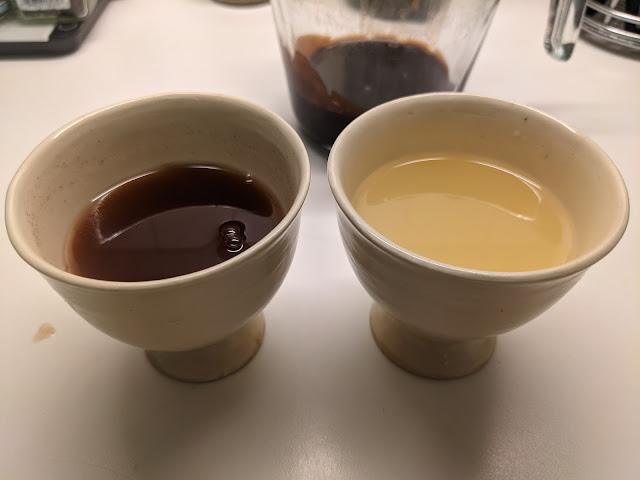Mijiaya, or Going Retro
On the outskirts of Xi'an, the Chan River flows. It eventually meets the Wei River, which flows into the Yellow river. On a dusty terrace above the river is a site called Mijiaya, where excavations in the 2000s uncovered pottery dating from 3400 BCE to 2000 BCE.
Some of the earliest potter, from 3400 BCE to 2900 BCE, the late Yangshao period, includes parts of an amphora, an urn and a funnel. This May, some archaeologists at Stanford published an analysis of residue on the pottery: http://www.pnas.org/content/early/2016/05/18/1601465113
It's malted barley, along with millet, something called Job's tears, and some other starches.
I think this is awesome! We know that alcohol production in China predates writing. The Records of the Grand Historian (史記) from 50 BCE discusses King Zhou, the last king of the Shang dynasty, who reigned 1075–1046 BCE:
So we know that alcohol production was going strong by around 1000 BCE. The myths surrounding the invention of alcohol put it firmly in "definitely fictional prehistory" territory (Du Kang, this blog's namesake, was the mythical inventor, and he supposedly worked for the Yellow Emperor himself). Some historical texts push "documentable" wine back to the early Xia dynasty, but I don't trust historians writing about events that happened 1500 years prior to them very much.
The pottery evidence in Science and Civilisation does go back to 3000 BCE and beyond. The authors suspect malted grain as the sugar source, as well as fruits. There are a variety of different words for alcohol with different significances but that's not worth digging into here.
Science and Civilisation suggests that these beverages were made by mixing cooked grain (millet, rice) with malted barley. There's a long argument about when the fungal mash I've been using in the rest of this blog came about, but by 200 BCE it was all anyone was using. Qimin Yaoshu has instructions for malting wheat and barley, but only uses it to make sugar.
This is a bit outside of what I've been working on, but it should be a fun break while I work on making enough different wines for Pennsic.
Stay tuned for an attempt at a recipe! I've got whole barley, Job's tears and more millet standing by.
Some of the earliest potter, from 3400 BCE to 2900 BCE, the late Yangshao period, includes parts of an amphora, an urn and a funnel. This May, some archaeologists at Stanford published an analysis of residue on the pottery: http://www.pnas.org/content/early/2016/05/18/1601465113
It's malted barley, along with millet, something called Job's tears, and some other starches.
I think this is awesome! We know that alcohol production in China predates writing. The Records of the Grand Historian (史記) from 50 BCE discusses King Zhou, the last king of the Shang dynasty, who reigned 1075–1046 BCE:
[He] made a pond of wine, hung the trees with meat, made men and women chase each other about quite naked, and had drinking bouts the whole night long. sourceScience and Civilisation in China includes pictures of brewing vessels - amphorae, urns, funnels - from that era, which have residues of Foxtail millet. Liquid wine was found in a bronze Shang dynasty vessel at Tianhu Village in Hebei but no analysis was done on it, and one kind of alcoholic beverage, 醴 (lǐ) is mentioned on Shang oracle bones.
So we know that alcohol production was going strong by around 1000 BCE. The myths surrounding the invention of alcohol put it firmly in "definitely fictional prehistory" territory (Du Kang, this blog's namesake, was the mythical inventor, and he supposedly worked for the Yellow Emperor himself). Some historical texts push "documentable" wine back to the early Xia dynasty, but I don't trust historians writing about events that happened 1500 years prior to them very much.
The pottery evidence in Science and Civilisation does go back to 3000 BCE and beyond. The authors suspect malted grain as the sugar source, as well as fruits. There are a variety of different words for alcohol with different significances but that's not worth digging into here.
Science and Civilisation suggests that these beverages were made by mixing cooked grain (millet, rice) with malted barley. There's a long argument about when the fungal mash I've been using in the rest of this blog came about, but by 200 BCE it was all anyone was using. Qimin Yaoshu has instructions for malting wheat and barley, but only uses it to make sugar.
This is a bit outside of what I've been working on, but it should be a fun break while I work on making enough different wines for Pennsic.
Stay tuned for an attempt at a recipe! I've got whole barley, Job's tears and more millet standing by.
This work is licensed under a Creative Commons Attribution-ShareAlike 4.0 International License.



Comments
Post a Comment